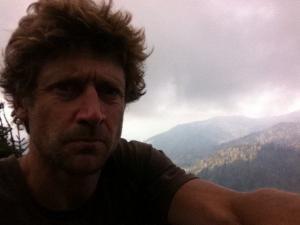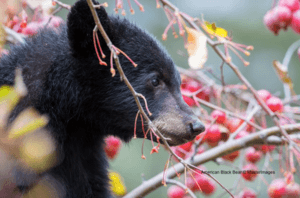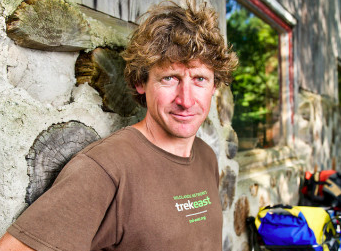Trekking for Rewilding – Exploring Strands of an Eastern Wildway
Text and photos by John Davis
Wildlands Network/TrekEast
Dave Foreman summarized brilliantly in his latest Around the Campfire why we need an Eastern Wildway and what basic steps need to be taken to achieve it. As a Rewilding Fellow, and co-founder of the Wildlands Project with Dave and other such conservation luminaries as Reed Noss and Michael Soulé twenty years ago, I’d like to offer some additional observations from a trek I’m taking north through our envisioned Eastern Wildway. First a bit about the trek.
Having been working with such leading conservationists as the aforementioned and many others (through my past editorship of Wild Earth and oversight of the Foundation for Deep Ecology’s Wilderness & Biodiversity granting program), I decided some time back that before I became as lame as my beloved Uncle Dave, I should cross the continent without supplemental octane, hiking, paddling, bicycling and otherwise propelling myself through and past the wild places that our wildlands community has been laboring for decades to protect, expand, and reconnect. I’d thought maybe age 50 (2013) would be the time to start this long journey, but when my mother, Mary Byrd Davis (whom some of you know for her work with Wild Earth magazine and her Eastern Old-Growth Surveys), was diagnosed with cancer, I decided I better get going, or my folks might not be able to experience the wildways odyssey with me. (Some of you also know that my mother died soon after instructing me to proceed with the journey and after my reemergence from a week in the Everglades—for which she uttered one of her final words: ‘Wonderful’!)
From the start, three groups have been especially helpful in my trek planning: The Rewilding Institute has provided the bedrock conservation understanding and strategy that guide where I go and what I seek. Dave Foreman and Howie Wolke’s The Big Outside and Dave’s Rewilding North America basically list and explain the ingredients for rewilding the East. The Adirondack Council, where I was conservation director from 2005 to 2010, was immediately supportive and understanding when I told them, sadly, it was time for me to go, else I’d never make this needed journey. They remain very much part of the trip, though I’m no longer on staff there. The Wildlands Network has organized and conducted the whole communications effort associated with what we now call TrekEast. Without the tireless support of Margo McKnight, Executive Director, and Keith Bowers, President, and their amazingly generous and skilled staff and board, my continental crossing would be a quiet walk in the woods. With their help, it is becoming an outreach tool and communications initiative enabling us to talk with people we’ve never reached before. (Please see http://wildlandsnetwork.org/trekeast pages, and send your thoughts and your own wildway experiences. Notwithstanding my technological primitiveness, TrekEast is now on Facebook and Twitter as well as the Wildlands Network website.)
In short, with the guidance of friends and colleagues from these three kindred groups and others, I am exploring on foot and canoe and bicycle the relatively intact parts of the Appalachian Mountains and Atlantic Seaboard that can be woven back together into an Eastern Wildway. I write a blog for the Wildlands Network website and talk with fellow conservationists at numerous stops along the way and out in the field wherever possible. Here are a few of my basic observations, from a mid-way stop in central Kentucky, followed by a brief account of a typical week in the life of TrekEast.
Suggestions from a Traverse of the Southeast
Florida’s conservation picture is far from finished. At least ten million acres in the state remain undeveloped but unprotected. Restoring the Panther to its rightful place across the East will require protecting Florida’s ecological corridors, in large part through conservation easements on ranchlands, getting the big cat safely back into the Florida Panhandle and into Georgia’s Okefenokee Swamp and Alabama’s Conecuh National Forest, and ensuring at least wide riparian corridors from there into the mountains. (Active reintroductions may be necessary because female Panthers will not usually cross major water bodies such as the Loxahatchie River, dredged into a barrier discouraging the big female cats from moving into northern Florida.)
The Southeast Coastal Plain still has sizable areas of natural or semi-natural habitat. Key to linking these areas, such as in South Carolina’s ACE Basin and North Carolina’s Albemarle Peninsula, with larger roadless areas in the Appalachian Mountains, will be the big rivers. Not only are rivers natural corridors, in the coastal plain many still have broad riparian forest buffers (having been too flood-prone to farm or develop). Accordingly, dams are nearly as big a problem in some developed areas as are roads. Conversely, Longleaf Pine restoration can help reconnect coast, foothills, and mountains.
The Piedmont, or foothills region, is perhaps the least well-protected part of the Southeast. Connections between the coastal plain and the mountains must be protected soon or will be lost. Longleaf Pine forest is the matrix that should connect these two broad physiographic types, even as the rivers bind them. Uwharrie National Forest and the Sandhills in North Carolina are critical links between coast and mountains.
Recovery efforts for Panther, Red Wolf, Black Bear, River Otter, Bobwhite Quail, Red-cockaded Woodpecker, Gopher Tortoise, Eastern Indigo (snake), and Brook Trout, to mention just a few charismatic species, can benefit greatly from the help of institutions that thus far conservation advocacy groups have not worked with much, such as zoos and aquaria, the Longleaf Alliance, Archbold and other biological research stations, hunting and angling clubs, and birding groups. Already, zoos and biological research stations are doing much of the work for recovery of Red Wolves, Florida Scrub Jays, Red-cockaded Woodpeckers, and rare reptiles and amphibians.
Dave’s last Campfire outlined the key steps for rewilding the Appalachians. His next issue will focus on specific incremental steps needed to gain footholds in strategic areas. Especially critical will be protecting all remaining roadless areas, closing unneeded back-country roads on the public lands, renewing funding for state and federal land conservation programs, removing unneeded dams, and building safe wildlife crossings on major roads.
A Week on the Blue Ridge
The Southern Appalachians, largely in the Blue Ridge physiographic province, are biologically as rich as almost any area in America. They rank high nationally or globally in species richness of salamanders, land snails, mussels, trees, and extent of remaining original forest (old growth) and wildlands.  So I spent several wonderful weeks rambling through these old mountains, guided where possible by biologists. One fairly typical week included meetings with leaders of the Southern Appalachian Forest Coalition, Wilderness Society, Open Space Institute, Wildacres, and Wild Law. It included a day afield with the great old-growth sleuth Rob Messick, who took me to some of the biggest Tulip Poplars and oldest oaks I’ve ever seen, in the Black Mountains southeast of the Blue Ridge Parkway. Seeing fresh bear scat and generations of bear claw marks on the huge trees reminded me why talented people like Rob have worked tirelessly for decades to save these ancient forest remnants.
So I spent several wonderful weeks rambling through these old mountains, guided where possible by biologists. One fairly typical week included meetings with leaders of the Southern Appalachian Forest Coalition, Wilderness Society, Open Space Institute, Wildacres, and Wild Law. It included a day afield with the great old-growth sleuth Rob Messick, who took me to some of the biggest Tulip Poplars and oldest oaks I’ve ever seen, in the Black Mountains southeast of the Blue Ridge Parkway. Seeing fresh bear scat and generations of bear claw marks on the huge trees reminded me why talented people like Rob have worked tirelessly for decades to save these ancient forest remnants.
Sad and sobering, in contrast, were the walks in Joyce Kilmer Memorial Forest and Linville Gorge, where the relatively small size of the Wilderness Areas and the spread of the Hemlock Wooly Adelgid, an exotic species, has left most of the great Eastern and Carolina Hemlocks dead or dying.  Small wildlands, I was reminded, are highly susceptible to pests and pathogens brought in by roads and motor vehicles or even, ironically, by natural vectors such as wind or birds. Walking among the huge hemlocks dynamited to the ground by the Forest Service at Joyce Kilmer was a painful reminder of what our beloved forests will face if we do not greatly enlarge and reconnect wildlands and keep out exotic species.
Small wildlands, I was reminded, are highly susceptible to pests and pathogens brought in by roads and motor vehicles or even, ironically, by natural vectors such as wind or birds. Walking among the huge hemlocks dynamited to the ground by the Forest Service at Joyce Kilmer was a painful reminder of what our beloved forests will face if we do not greatly enlarge and reconnect wildlands and keep out exotic species.
Reviving my hope was a field trip with Brad & Shelly Stanback, on the Stanbacks’ wild farm near Asheville. There, Brad & Shelly are working with the American Chestnut Foundation to cross-breed blight resistance into chestnut trees, in hopes one day this food-rich tree can regain its place as a foundational species in the Southern and Central Appalachians. Genetics is what scared me away from biology in college, so I won’t try to repeat here Brad’s scientific explanations of the cross-breeding and planting programs, or the generous attempts of Ron Sutherland, staff biologist for the Wildlands Network’s Southeast program, to simplify the science enough for my small mind to absorb. Suffice to say, chestnut restorationists have been successful enough already to have a chestnut tree that is 15/16 American Chestnut (the remainder Chinese Chestnut, from whence come genes conferring resistance to the chestnut blight) and bears fruit. It may be decades before chestnuts are once again feeding bears and turkeys and deer and other mast-eaters far and wide, and only a miracle would have them feeding Passenger Pigeons again; but an amazing recovery story has begun on the Stanbacks’ and other experimental restoration sites in the Southeast.
All through the Carolinas, I was hearing stories of what a crucial role conservation benefactors like the Stanbacks play in supporting programs to protect and restore wildlands and wildlife. Other beneficiaries of wildlands philanthropy have included River Otters, which have been successfully reintroduced to many rivers in the Southeast; Black Bears, which are recolonizing much of their original range, too, with a boost from bear sanctuaries in the Smoky Mountains and elsewhere; Beavers, which are thriving on many privately protected stream stretches; and rare reptiles, which are being assisted by a great new privately funded conservation effort called Project Orianne. So a final observation for now is that a few determined people really can save mountains!
In short, half way into TrekEast (about 3400 miles of an anticipated 6000), I find on the land threats unabated but also an amazing resilience – enough strength yet in the land to hope we can achieve an Eastern Wildway. Sturdy wild strands remain, and so do good people with the passion to tie them back together — if we can but convince enough Americans to join us in restoring our natural heritage.
—John Davis, heading east to Daniel Boone National Forest’s Clifty Wilderness
Follow John’s adventure via his Wildlands Network blog: http://wildlandsnetwork.org/trekeast/blog
John Davis is executive director of The Rewilding Institute and editor of Rewilding Earth. For Rewilding, he serves as a wildways scout, editor, interviewer, and writer. He rounds out his living with conservation field work, particularly within New York’s Adirondack Park, where he lives. John serves on boards of RESTORE: The North Woods, Eddy Foundation, Champlain Area Trails, Cougar Rewilding Foundation, and Algonquin to Adirondack Conservation Collaborative.
John served as editor of Wild Earth journal from 1991-96, when he went to work for the Foundation for Deep Ecology, overseeing their Biodiversity and Wildness grants program from 1997-2002. He then joined the Eddy Foundation as a board member and continues to serve as volunteer land steward for that foundation in its work to conserve lands in Split Rock Wildway. This wildlife corridor links New York’s Champlain Valley with the Adirondack High Peaks via the West Champlain Hills. John served as conservation director of the Adirondack Council from 2005 to 2010.
In 2011, John completed TrekEast, a 7600-mile muscle-powered exploration of wilder parts of the eastern United States and southeastern Canada—sponsored by Wildlands Network and following lines suggested in Dave Foreman’s book Rewilding North America—to promote restoration and protection of an Eastern Wildway. In 2012, John wrote a book about that adventure, Big, Wild, and Connected: Scouting an Eastern Wildway from Florida to Quebec, published by Island Press.
In 2013, John trekked from Sonora, Mexico, north along the Spine of the Continent as far as southern British Columbia, Canada, again ground-truthing Rewilding North America and promoting habitat connections, big wild cores, and apex predators—all of which would be well served by fuller protection of the Western Wildway he explored. John continues to work with many conservation groups to protect and reconnect wild habitats regionally and continentally.
John is available to give public talks on rewilding, conservation exploration, and continental wildways, as well as to write and edit on these subjects. He is also available for contract field work, particularly monitoring conservation easements, documenting threats to wildlands, and marking conservation boundaries. He can be reached at john@rewilding.org and hemlockrockconservation@gmail.com (for his land-care work).


